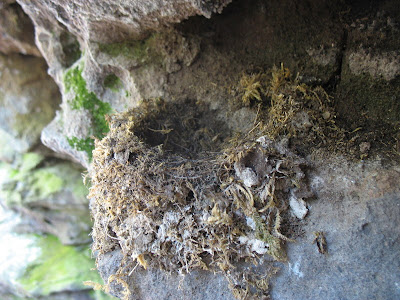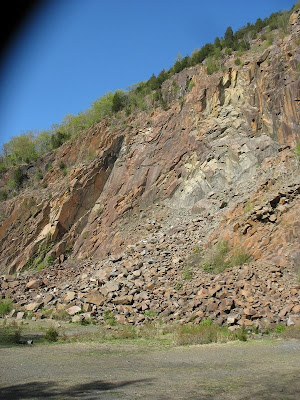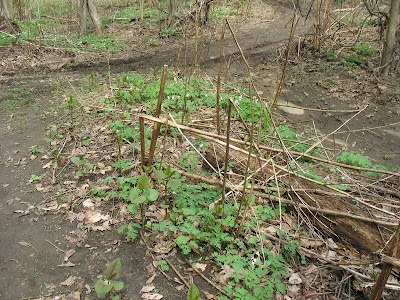 It was five months ago that I journey down the west slope of Sleeping Giant at dusk, having lingered too long at the top looking for treasure. My intentions were to return soon, as I had unfinished business there, but Mother Nature intervened and coated with the slopes with ice and snow for the season. Yesterday I finally returned to the Tuttle Ave parking area for the Red Trail and was greeted by a host of spring wild flowers. That's Red Trillium above.
It was five months ago that I journey down the west slope of Sleeping Giant at dusk, having lingered too long at the top looking for treasure. My intentions were to return soon, as I had unfinished business there, but Mother Nature intervened and coated with the slopes with ice and snow for the season. Yesterday I finally returned to the Tuttle Ave parking area for the Red Trail and was greeted by a host of spring wild flowers. That's Red Trillium above. The tiny Fringed Polygala was quite dramatic along the lower trail. I wondered if I had found something rare (this is possible at the Giant), but there was a handwritten note in my copy of Newcomb's Wildflower Guide that I had seen this same species in 1992 -- at Sleeping Giant.
The tiny Fringed Polygala was quite dramatic along the lower trail. I wondered if I had found something rare (this is possible at the Giant), but there was a handwritten note in my copy of Newcomb's Wildflower Guide that I had seen this same species in 1992 -- at Sleeping Giant. The red circle trail follows a stream to the top of the ridge, at one point taking you high above Gorges Cascades, a mini-canyon of sorts. A bit higher was a classy waterfall that this picture does not do justice to, alongside a small cave. The cave rock was conglomerate (sedimentary rock) and the falls flowed over "trap rock" or basalt (previously molten rock), so there's a bit of geology going on there.
The red circle trail follows a stream to the top of the ridge, at one point taking you high above Gorges Cascades, a mini-canyon of sorts. A bit higher was a classy waterfall that this picture does not do justice to, alongside a small cave. The cave rock was conglomerate (sedimentary rock) and the falls flowed over "trap rock" or basalt (previously molten rock), so there's a bit of geology going on there. An old bird nest was built right into the side of the cave next to the falls. I don't know what kind.
An old bird nest was built right into the side of the cave next to the falls. I don't know what kind. Bloodroot and Dutchman's Breeches were done blooming, but their delicate leaves hadn't yet gone dormant.
Bloodroot and Dutchman's Breeches were done blooming, but their delicate leaves hadn't yet gone dormant. Dwarf Ginseng was all over the lower slopes.
Dwarf Ginseng was all over the lower slopes. The stream goes up and up and eventually leads through a notch in the ridge to this sprawling red maple swamp on the mountain.
The stream goes up and up and eventually leads through a notch in the ridge to this sprawling red maple swamp on the mountain. Turning onto the blue-blazed Quinnipiac, the terrain became rockier and drier, home to the occasional Columbine.
Turning onto the blue-blazed Quinnipiac, the terrain became rockier and drier, home to the occasional Columbine. Last time I was here the trees were bare. What a sight to see!
Last time I was here the trees were bare. What a sight to see!Letterboxing at the Giant is strenuous. It may seem like there are a lot of boxes in the park, but there are many miles of trails and the boxes are really spread out. I generally find I'm spending at least one hour per find. This time I spent eight hours for five finds (and five not found). Many of the boxes are older and have gone missing, or if you do find them, they may be wet. But there are a lot of real classics and great carvings, and if you go looking for them all I guarantee you will find yourself exploring all sorts of nooks and crannies you never knew existed at the Giant.
 After descending the west slope, I couldn't help but drive around to the main parking area to look for a few more, returning to the Mill River...
After descending the west slope, I couldn't help but drive around to the main parking area to look for a few more, returning to the Mill River... ...and the quarry (see the grayish spot on the cliff to the right? That's where a chunk of the mountain collapsed a couple years ago)...
...and the quarry (see the grayish spot on the cliff to the right? That's where a chunk of the mountain collapsed a couple years ago)... ...and the ruins of the quarry infrastructure.
...and the ruins of the quarry infrastructure. And that's all for now: I've looked for every box that I know of at the Giant. On to some other park.

























